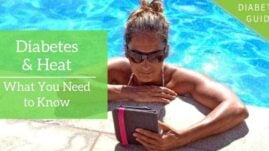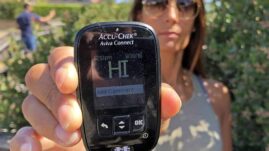Warm water has a way of calming the body, easing tight muscles, and slowing the pace of a busy day.
For people who live with diabetes, though, questions sometimes linger beneath the surface: Can my bath raise my blood sugar? Could a hot shower lower it too much? Is there anything I should watch for?
The connection between water temperature, circulation, and glucose balance is surprisingly practical once you understand how the body responds. This article unpacks those reactions in plain terms to help you enjoy your daily routine safely and confidently.

Table of Contents
- How the body reacts to warm water
- Why some people experience lower blood sugar after hot baths or showers
- How cold showers affect blood sugar
- Timing matters more than people think
- Why very hot water can become risky
- What about Epsom salt baths?
- How humidity and steam interact with glucose levels
- When to be cautious
- Small habits that help keep readings steady
- What research says—and what it doesn’t
- Listening to your body remains the best guide
How the body reacts to warm water
Warm water triggers noticeable physical changes. Blood vessels widen, muscles relax, and the heart may beat a bit faster. These shifts can cause glucose levels to move subtly or, in some cases, more dramatically.
When vessels widen, blood flows more freely to the skin and limbs. This can help the body use glucose more effectively.
Some people see a gentle drop in their readings after a hot bath or shower. For others, the change is mild or barely visible.
The variation happens because each person’s physiology, medications, and recent meals influence the outcome.
Warm water can also reduce cortisol, a hormone linked to stress. Lower cortisol can help stabilize blood sugar, especially for people who notice spikes during stressful moments. That said, the effect is not universal; it simply adds another piece to the puzzle.
NOTE: Because diabetes is never straightforward, some people report the exact opposite effect. Their blood sugar increases during and after a hot shower, possibly because their bodies perceive the heat as stressful rather than relaxing and therefore release stress hormones.
Why some people experience lower blood sugar after hot baths or showers
A hot bath can act almost like light exercise. It doesn’t burn calories the same way movement does, but it increases circulation, which may help muscle cells pull more glucose from the bloodstream. That’s why some people with diabetes notice a small downward shift in blood sugar after stepping out of the tub.
If you use insulin, the temperature change can enhance absorption. Insulin injected into warm tissue can be absorbed faster. Faster absorption means a quicker drop, which may catch you off guard if you’re not expecting it. This effect becomes more noticeable with hotter water or when you shower soon after injecting insulin.
For people using GLP-1 therapies such as Ozempic or Mounjaro, the effect varies. These medications slow digestion, so a hot bath may amplify sensations of fullness or mild nausea, which might reduce how much you eat afterward—indirectly influencing blood sugar. The water itself doesn’t interfere with the medication.
Some individuals only feel a small dip. Others feel light-headed, especially if they were already trending low. Understanding your pattern takes a bit of observation and some honest tracking.
How cold showers affect blood sugar
Cold water sends an opposite signal. Blood vessels tighten, which preserves heat around your core. This response may cause a short rise in glucose because the body releases stored sugar to maintain energy during a mild stress reaction.
People who enjoy cold showers or contrast therapy (hot to cold) sometimes see slight bumps in their readings. For most, the shift is temporary and not harmful. Still, if you’re working hard to bring down elevated numbers, this brief rise can be frustrating.
Cold exposure can be helpful for muscle recovery, inflammation, or simply waking up with more energy. It just may influence your glucose trend for a short stretch afterward.
Timing matters more than people think
A warm shower right after exercise feels amazing, but it might lower your blood sugar faster than you expected. Exercise already increases insulin sensitivity. Pairing that with heat can exaggerate the effect.
A shower before a meal may lower your numbers slightly, while a hot soak after a carb-heavy dinner might reduce post-meal spikes for some people. That said, these shifts aren’t reliable enough to be used as a tool for glucose management; they are simply natural reactions worth keeping in mind.
The timing of your medications also plays a role:
- Rapid-acting insulin: A hot bath taken within 60 to 90 minutes of a bolus can speed absorption.
- Continuous glucose monitors (CGMs): Hot water can occasionally cause false “compression-like” lows or mild sensor drift, especially if the water is very hot. Dexcom, Libre, and Medtronic devices note this in their guidance.
- Insulin pumps: Tubing and pods generally tolerate normal bath temperatures, but extremely hot water can weaken adhesive or introduce small air bubbles in tubing systems.
Note: I often experience that my Dexcom CGM gives an artificially high reading when I am in the shower. I have learned to wait a few minutes after getting out to correct highs to give the CGM time to adjust.
Why very hot water can become risky
Prolonged exposure to very hot water may increase the chance of dizziness or faintness. People who have neuropathy, low blood pressure, or a history of autonomic issues should be especially cautious. Because neuropathy can dull temperature sensation, water that feels mildly warm to the hand could actually be too hot for the feet or legs.
Scalding risk is higher for people with reduced sensation, which is why podiatrists often recommend checking water with a thermometer or elbow rather than relying on foot sensation. The U.S. Consumer Product Safety Commission suggests 120°F (49°C) or lower for home water heaters to reduce burn risk.
If you live with autonomic neuropathy, your blood pressure can drop more quickly during heat exposure, raising the risk of a sudden fall when you stand.
What about Epsom salt baths?
Epsom salt baths have a loyal following. Magnesium is involved in blood pressure regulation, nerve function, and glucose balance. While soaking in Epsom salt won’t meaningfully raise magnesium levels for most people, many still find the baths soothing.
There’s no strong evidence that Epsom salt directly lowers blood sugar. However, the relaxation it provides might help reduce stress-related glucose fluctuations.
People with advanced kidney disease should ask their clinicians before using large amounts of magnesium-based bath products. Most people without kidney issues can use them safely.
How humidity and steam interact with glucose levels
Steam from a long, hot shower can cause mild dehydration if you don’t drink enough water during the day. Even slight dehydration can raise blood sugar because there is less fluid in your bloodstream, which makes glucose more concentrated.
If you live in a dry climate or take very warm showers, it might be helpful to drink a glass of water before or after your routine. Staying hydrated can reduce headaches, fatigue, and mild glucose spikes.
People who use CGMs may also notice that adhesives soften or loosen in humid conditions. CGM overlay patches like Skin-Grip can help keep sensors secure.
When to be cautious
Baths and showers are generally safe for people with diabetes, but a few situations call for extra awareness.
1. Recent insulin injections
If you injected insulin less than an hour before getting in a hot bath, the heat may accelerate absorption. This can lead to a sharper drop than expected. A CGM trend arrow or a quick finger-stick check can help you make a safe choice.
2. A history of fainting or very low blood pressure
Heat dilates blood vessels, which can trigger dizziness when standing. If this is common for you, sit in the tub rather than lying fully submerged, and get up slowly.
3. Nerve damage in the feet
Neuropathy can make burns more likely. Checking water temperature with your elbow or a bath thermometer gives an added layer of safety.
4. Open wounds or foot ulcers
Warm water softens the skin, which can delay healing or increase infection risk. Many clinicians recommend cleansing with gentle running water instead of soaking.
5. Dehydration
Heat can worsen dehydration, which often pushes blood sugar higher. Drinking throughout the day helps prevent this.
Small habits that help keep readings steady
You don’t need elaborate routines. A few simple habits can help you stay steady while still enjoying the comfort of warm water.
- Keep snacks nearby – A small carton of juice or glucose tablets in the bathroom can be reassuring. Even if you rarely need them, they remove the stress of “What if I go low while I’m in here?”
- Check your CGM trend arrow before getting into very hot water – If the arrow is pointing downward, consider waiting a few minutes, having a small snack, or simply choosing a lukewarm temperature.
- Set a gentle time limit for very hot baths – Most people do well with 10–20 minutes. Longer sessions may increase your risk of dehydration or dizziness.
- Take your time standing up – Hot showers can pool blood in the legs. Standing slowly gives your body a smoother transition.
- Stay hydrated – A glass of water before or after your shower can help counter mild fluid loss from steam.
- Use non-slip mats if you feel unsteady – These help prevent falls, especially if you mix hot and cold therapy or if you’re prone to light-headedness.
What research says—and what it doesn’t
A few small studies have explored the effects of hot baths on glucose control. The most cited study, published in The New England Journal of Medicine, found that repeated hot baths lowered fasting glucose in a small group of people with type 2 diabetes. The proposed mechanism was increased blood flow and mild metabolic stimulation.
However, these studies are small, and the results aren’t consistent enough to treat heat as a medical intervention. The research does suggest that heat has measurable effects on circulation, stress hormones, and insulin sensitivity. But daily living, not therapy, remains the best framework for thinking about baths and showers.
Listening to your body remains the best guide
Your glucose readings, your symptoms, and your comfort level form the most reliable combination of information. The goal is not to micromanage every shower but to understand your personal patterns.
If you notice that hot showers consistently lead to lows, adjusting your routine (even slightly) can make mornings smoother. If cold showers give you a temporary glucose bump, you’ll know to expect it and avoid unnecessary worry.
Patterns matter. Perfection does not.




